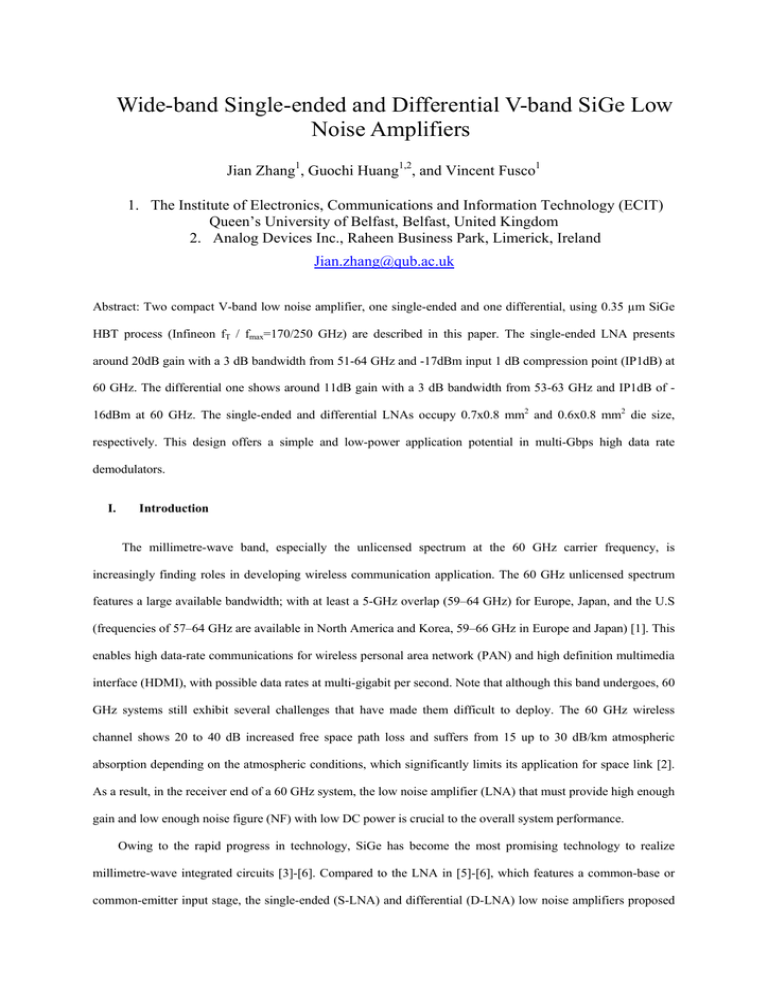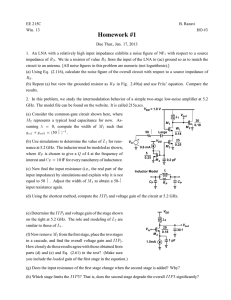Wide-band Single-ended and Differential V
advertisement

Wide-band Single-ended and Differential V-band SiGe Low Noise Amplifiers Jian Zhang1, Guochi Huang1,2, and Vincent Fusco1 1. The Institute of Electronics, Communications and Information Technology (ECIT) Queen’s University of Belfast, Belfast, United Kingdom 2. Analog Devices Inc., Raheen Business Park, Limerick, Ireland Jian.zhang@qub.ac.uk Abstract: Two compact V-band low noise amplifier, one single-ended and one differential, using 0.35 µm SiGe HBT process (Infineon fT / fmax=170/250 GHz) are described in this paper. The single-ended LNA presents around 20dB gain with a 3 dB bandwidth from 51-64 GHz and -17dBm input 1 dB compression point (IP1dB) at 60 GHz. The differential one shows around 11dB gain with a 3 dB bandwidth from 53-63 GHz and IP1dB of 16dBm at 60 GHz. The single-ended and differential LNAs occupy 0.7x0.8 mm2 and 0.6x0.8 mm2 die size, respectively. This design offers a simple and low-power application potential in multi-Gbps high data rate demodulators. I. Introduction The millimetre-wave band, especially the unlicensed spectrum at the 60 GHz carrier frequency, is increasingly finding roles in developing wireless communication application. The 60 GHz unlicensed spectrum features a large available bandwidth; with at least a 5-GHz overlap (59–64 GHz) for Europe, Japan, and the U.S (frequencies of 57–64 GHz are available in North America and Korea, 59–66 GHz in Europe and Japan) [1]. This enables high data-rate communications for wireless personal area network (PAN) and high definition multimedia interface (HDMI), with possible data rates at multi-gigabit per second. Note that although this band undergoes, 60 GHz systems still exhibit several challenges that have made them difficult to deploy. The 60 GHz wireless channel shows 20 to 40 dB increased free space path loss and suffers from 15 up to 30 dB/km atmospheric absorption depending on the atmospheric conditions, which significantly limits its application for space link [2]. As a result, in the receiver end of a 60 GHz system, the low noise amplifier (LNA) that must provide high enough gain and low enough noise figure (NF) with low DC power is crucial to the overall system performance. Owing to the rapid progress in technology, SiGe has become the most promising technology to realize millimetre-wave integrated circuits [3]-[6]. Compared to the LNA in [5]-[6], which features a common-base or common-emitter input stage, the single-ended (S-LNA) and differential (D-LNA) low noise amplifiers proposed in this paper employ a cascode topology in concert with an active-matching design methodology to achieve simultaneous optimal noise and wideband input impedance match. II. Circuits Design 1. Single-end LNA design Fig.1 Simplified schematic of 60-GHz single-ended low noise amplifier A two-stage single-ended LNA was implemented as shown in Fig. 1. The first stage cascode amplifier was chosen for its simple input matching, its higher gain compared to an inductively degenerated common-emitter amplifier, and its high reverse isolation and higher stability compared to a common-base counterpart. The second stage consists of a common-emitter cascode amplifier without emitter degeneration for higher gain. The two stages provide 8dB and 10 dB of gain respectively when biased at 3mA under 3.3V DC supply. Single-stub tuners are used for the input, inter-stage, and output matching networks, with stub lengths of 400um for TL3, 250um for TL6 and series t-line lengths of 50um for TL2, 400um for TL1, 350um for TL5, and 300um for TL7 for the input, inter-stage and output networks matching.MIM ac coupling capacitors (C1, C2, C3) operating beyond selfresonance are used between the two stages, input and output. At 60 GHz, the silicon substrate exhibits low impedance; thus, care was taken in circuit design and layout to ensure adequate reverse isolation and stability. What’s more, both metal-1 and metal-2 ground shields are used throughout the amplifier. 2. Differential LNA design Fig.2 Simplified schematic of 60-GHz differential low noise amplifier The schematic of the proposed differential LNA is shown in Fig. 2. This LNA is composed of two stages. The first stage is a differential cascode amplifier using a LC impedance peaking network as load. This load impedance can be made very large across the desired frequency band in order to force the output current to flow into the following stage. However, in practice the series resistance in the transmission line inductor will limit the impedance peaking effect. In the design, transmission line, TL1 to TL3 as shown in Fig. 2, with 50 Ω characteristic impedance at the desired frequencies are introduced at the input stage for the purpose of impedance matching. Note that, at millimeter-wave frequencies, e.g. 60GHz, the base impedance of a bipolar transistor is relatively small compared with a 50 Ω transmission line. Therefore, the input impedance will be dominated by the characteristic impedance of the transmission line TL1. In the design, C1 and C2 are set to 1pF and the bond pad capacitance Cpad0 is less than 40fF. As a result, a good 50 Ω impedance matching can be achieved over a wide frequency band. The second stage is a conventional emitter coupled differential amplifier with high common mode rejection. It is used to amplify the desired signal and compress the common mode signal. The two stages are connected by a coupling capacitor C1. (a) (b) Fig.3 Micro-photography of the chips (a) single-ended LNA (b) differential LNA III. Measurements The presented two LNAs were fabricated using Infineon 0.35µm SiGe technology (fT / fmax=170/250 GHz). The microphotograph of the circuit is shown in Fig. 4 and Fig. 5. The die sizes of single-ended and differential LNA are 0.8*0.6 mm2 and 0.7*0.6 mm2 respectively. The circuits were measured on wafer. An Agilent E8361A network analyzer was used to measure the S-parameters. 20 10 S21 S-parameter(dB) 0 -10 S11 S22 -20 -30 S12 -40 -50 -60 50.0G 55.0G 60.0G 65.0G Frequency(GHz) Fig.4 Measured S-parameters of the single-ended LNA 70.0G 4 2 Output Power(dBm) 0 -2 -4 -6 -8 -10 -12 -14 -16 -18 -35 -30 -25 -20 -15 -10 Input Power(dBm) Fig.5 Measured 1dB compression point of the single-ended LNA The measured S-parameters for the single-ended LNA are shown in Fig. 4. The gain of the single-ended LNA is 19.5dB with a 3dB bandwidth ranging from 51-64 GHz. The measured input and output return loss is lower than -8dB and -6dB, respectively, from 50-70 GHz. The reverse isolation is less than -50 dB across the entire frequency band. Fig. 5 shows the measured input 1-dB compression point (IP1dB), which is -17.5dBm at 60GHz. The whole circuit dissipate 3 mA current from a 3.3V power supply. 20 10 S21 S-parameter(dB) 0 -10 S11 S22 -20 -30 -40 S12 -50 -60 50.0G 55.0G 60.0G 65.0G Frequency(GHz) Fig.6 Measured S-parameters of the differential LNA 70.0G -2 -4 -6 Output Power(dBm) -8 -10 -12 -14 -16 -18 -20 -22 -24 -26 -35 -30 -25 -20 -15 -10 Input Power(dBm) Fig.7 Measured 1dB compression point of the differential LNA The measured S-parameters for the differential LNA are shown in Fig. 5. The gain peaks at 11.5dB at 58 GHz with a 3 dB bandwidth ranging from 53-63 GHz. The input return loss is lower than -5dB from 55-65 GHz, while the output return loss is lower than -5dB. The S22 pole appears at 60GHz, which is around -12dB. The reverse isolation is lower than -50 dB across the entire frequency band .Fig. 7 shows the measured 1dB compression point of the differential amplifier at 60GHz, which is -16dBm. The measured noise figures for both amplifiers are not obtainable at the moment due to the limited measure equipment in the lab. IV. Conclusion: A single-ended and a differential V-band low noise amplifier using 0.35um SiGe HBT process (Infineon fT / fmax=170/250 GHz) are shown in this paper. The single-ended LNA presents around 20dB gain and 17dBm input P1dB with a 3dB bandwidth ranging from 51-64 GHz. The differential one exhibits around 11dB gain, -16dBm input P1dB and has a 3 dB bandwidth ranging from 53-63 GHz. The power dissipation for the single-ended and the differential LNAs are 9.9 and 49.5 mW, respectively. The chip area, which includes bonding pad, is only 0.7x0.8 mm2 for the S-LNA and 0.6x0.8 mm2 for the D-LNA. This design offers a simple and lowpower application potential in multi-Gbps high data rate demodulators. Acknowledgment This work was supported by the Europe Commission FP7 Marie Curie IAAP Action: Program ‘Radio technologies for short range gigabit wireless communications’. The authors would like to thank Infineon Technologies AG for fabricating the chips and its staff members in Infineon Technologies Austria AG for various discussions. Dr N. Buchanan is also acknowledged for making on-chip measurements Reference [1] Standard ECMA-387, “High rate 60 GHz PHY, MAC and PALs” Second Edition, Dec. 2010 [2] Reynolds, S.K.; Floyd, B.A.; Pfeiffer, U.R.; Beukema, T.; Grzyb, J.; Haymes, C.; Gaucher, B.; Soyuer, M., “A Silicon 60-GHz Receiver and Transmitter Chipset for Broadband Communications” Solid-State Circuits, IEEE Journal of, Volume. 41, Issue.12, 2006, pp.2820 – 2831 [3] Floyd, B.A.; Reynolds, S.K.; Pfeiffer, U.R.; Zwick, T.; Beukema, T.; Gaucher, B., “SiGe bipolar transceiver circuits operating at 60 GHz” Solid-State Circuits, IEEE Journal of, Volume. 40, Issue.1, 2005, pp.156-167 [4] Terry Yao; Gordon, M.Q.; Tang, K.K.W.; Yau, K.H.K.; Ming-Ta Yang; Schvan, P.; Voinigescu, S.P., “Algorithmic Design of CMOS LNAs and PAs for 60-GHz Radio” Solid-State Circuits, IEEE Journal of, Volume. 42, Issue.5, 2007, pp.1044-1057 [5] Floyd, B.A, “V-band and W-band SiGe bipolar low-noise amplifiers and voltage-controlled oscillators” Radio Frequency Integrated Circuits (RFIC) Symposium, 2004. IEEE Page(s): 295 - 298 [6] Yaoming Sun; Herzel, F.; Li Wang; Borngraber, J.; Winkler, W.; Kraemer, R., “An integrated 60 GHz receiver front-end in SiGe:C BiCMOS” Silicon Monolithic Integrated Circuits in RF Systems, 2006. Digest of Papers. 2006 Topical Meeting on


